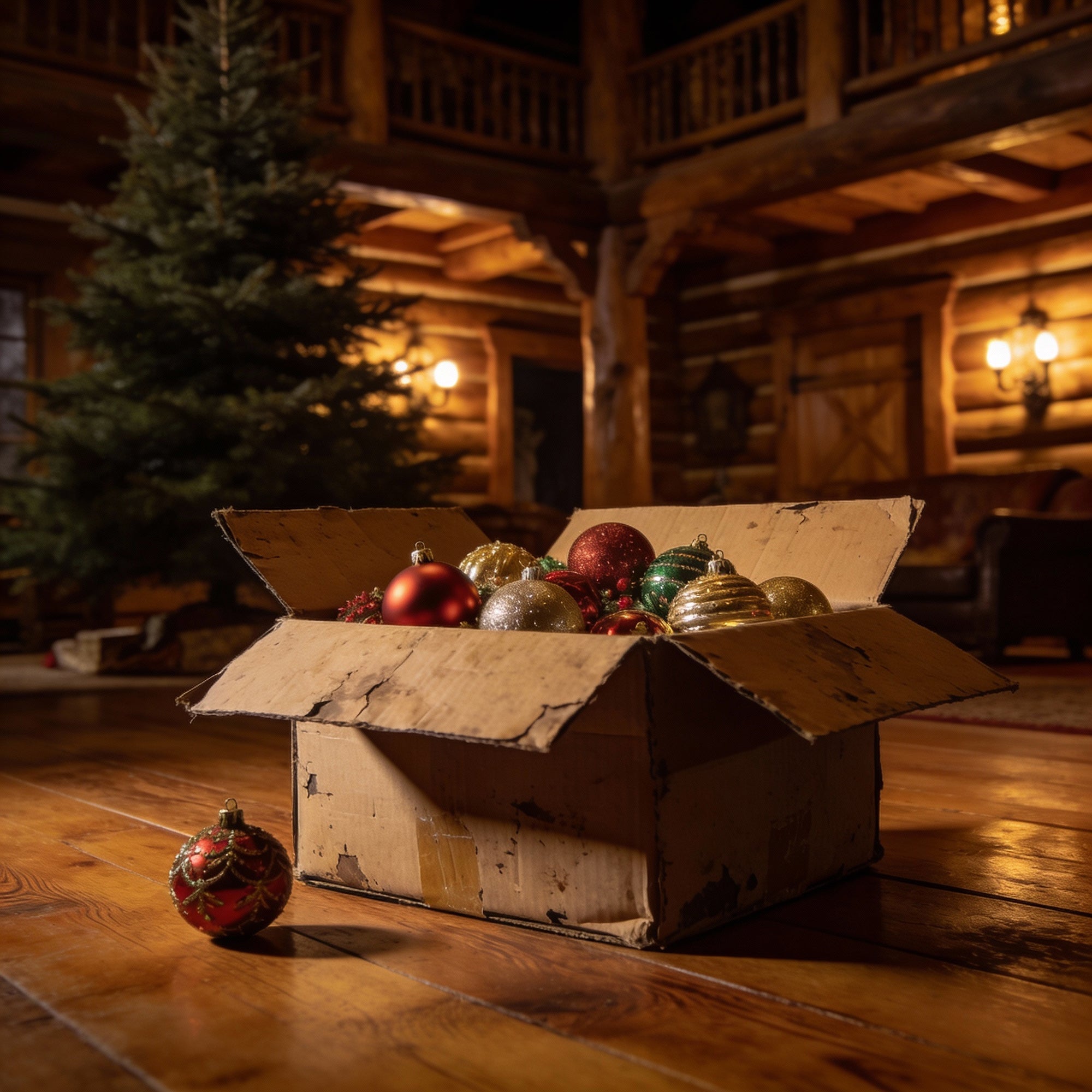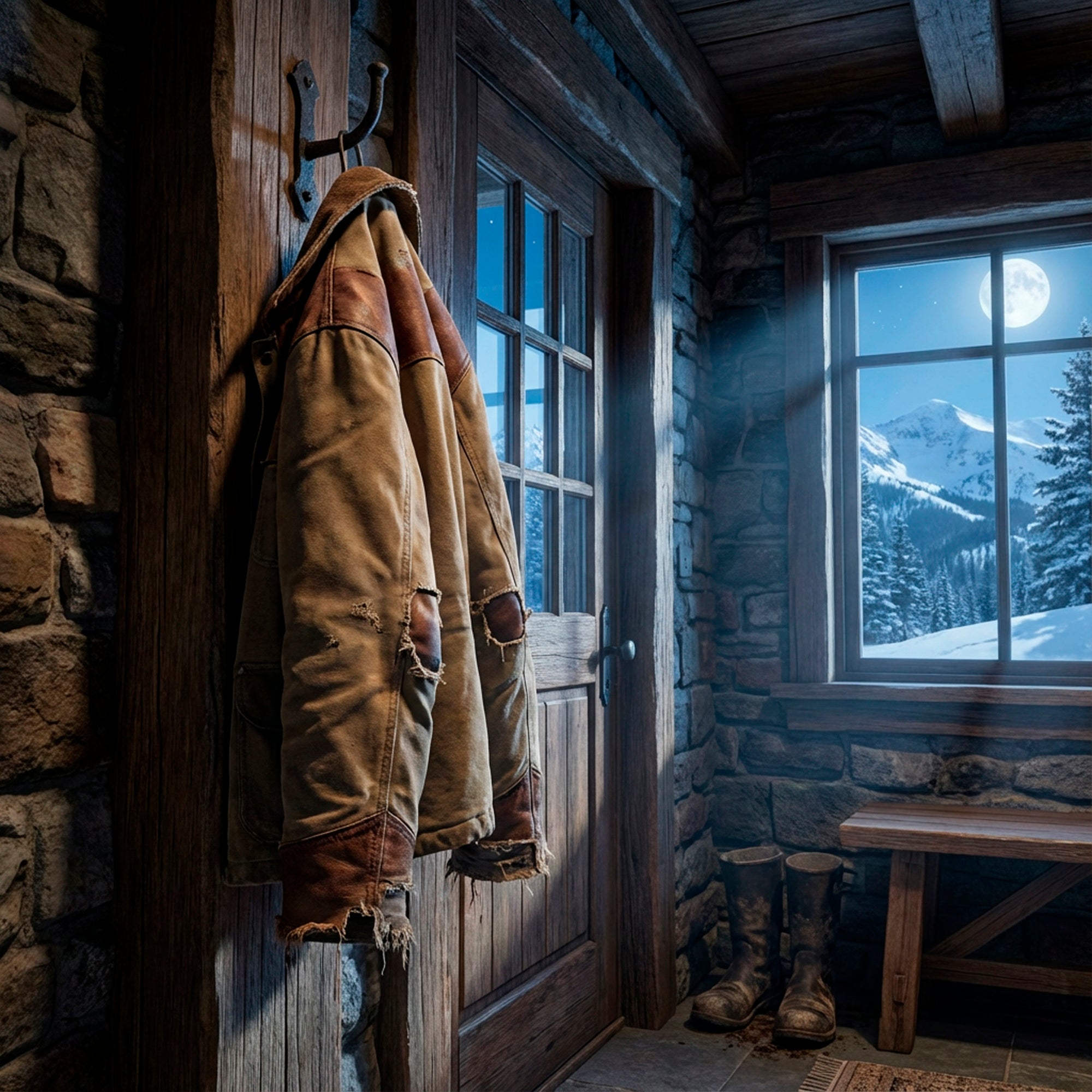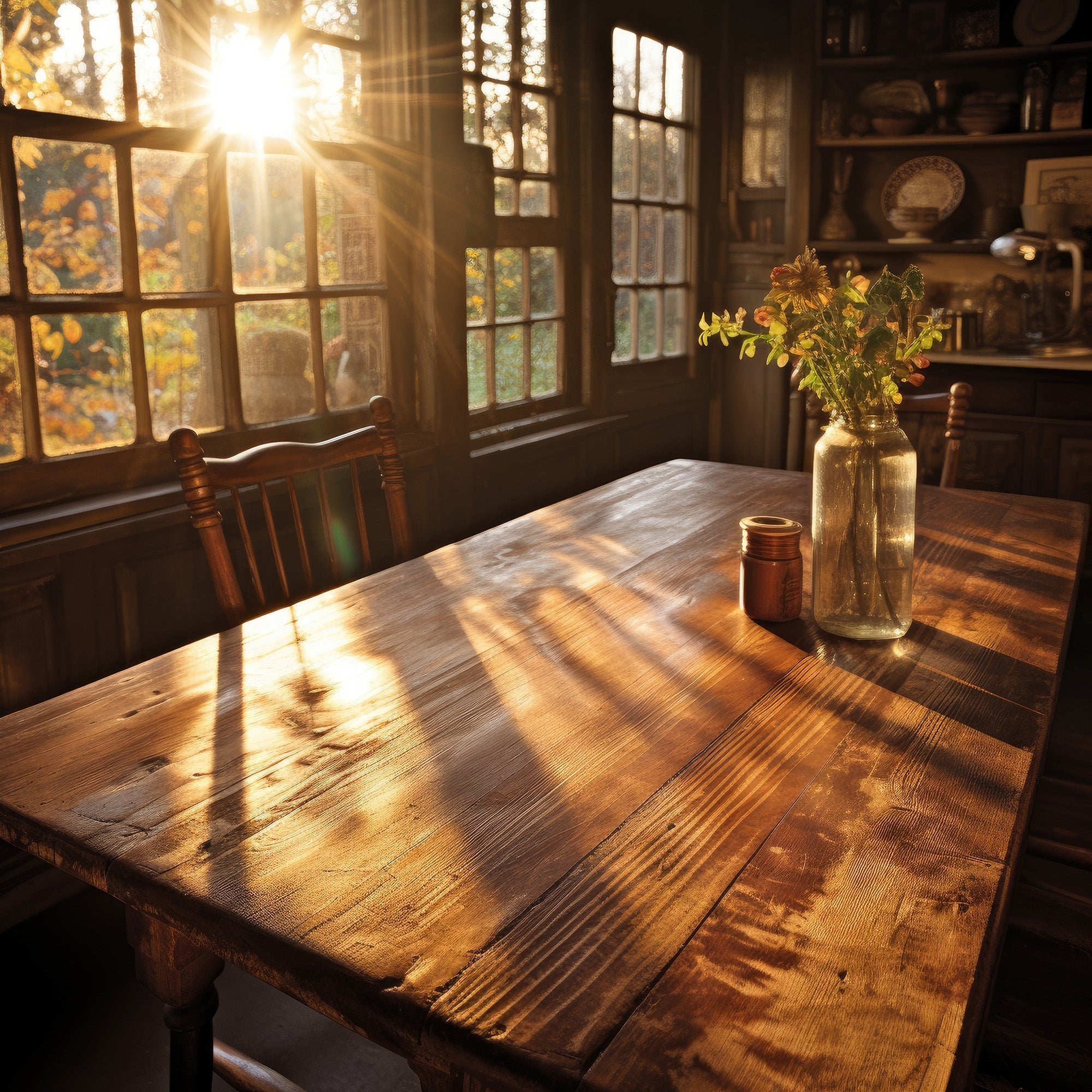There are a lot of beautiful pieces in a home, but only one you literally live with every single night: the bed.
In a Western or ranch-inspired space, the western bed is more than furniture. It’s architecture. It’s a backdrop for your quietest moments, your early-morning coffee, and the end of every long day. It sets the tone for the entire room — and if you choose well, it becomes the one piece that never gets replaced.
Walk into a truly great Western bedroom and you’ll notice something right away: everything else is playing off the bed. The iron lamps, the Pendleton® throw, the cowhide rug, even the way the windows are framed — they all orbit around one strong, grounded silhouette in the center of the room.
This guide is for the person who’s ready to invest in that silhouette. Maybe you’re furnishing a new ranch home or finally upgrading from a starter frame that never quite matched your vision. Maybe you’ve fallen in love with a particular western bed frame and want to be sure it’s the right one before you commit.
We’ll walk through what truly defines a western bed (and what’s just “Western-ish”), how to choose the right size and style for your room, how to layer bedding and décor so the space feels elevated instead of theme-y, and when it’s worth exploring a fully custom piece.
By the time you’re done, you’ll know exactly what you’re looking for — and how to recognize it the moment you see it.
What Makes a Bed Truly Western?
“Rustic” is everywhere. “Farmhouse” is everywhere. But a western bed has its own language — a mix of material, proportion, and detail that feels rooted in the landscapes of Texas, New Mexico, Colorado, Wyoming and beyond.
Here’s what separates a real western bed from a generic rustic frame.
1. Heirloom-worthy materials
The soul of a western bed is in what it’s made of and how it’s put together.
• Solid Woods With Character: Think alder, pine, oak, mango, parota and other hardwoods that take stain beautifully and show off grain. Western pieces often lean into knots, movement and variation instead of hiding them.
• Forged Iron, Not Flimsy Metal Tubing: Scroll-worked iron accents, strap details, or iron stretchers can give a western bed the weight it needs. These aren’t lightweight decorative pieces; they should feel like they were built by a blacksmith, not stamped out in a factory.
• Real Leather, Tooled Or Smooth: A luxury western bed might feature leather headboard panels, tooled leather insets, or boot-stitch patterns. Genuine leather patinas over time; faux leather doesn’t age, it just peels.
• Thoughtful Finishes: Western finishes are rarely flat. They’re layered: warm stains with hand-rubbed highlights, whitewash that lets grain peek through, or deep espresso tones with burnished edges. A great finish doesn’t fight your bedding; it frames it.
2. Weight and presence
A western bed doesn’t have to be oversized, but it should feel anchored.
• Headboards are often taller and more substantial, sometimes echoing church doors, cattle guards, or adobe arches.
• Side rails and footboards are usually wider and thicker than typical mass-market frames.
• Even a lower-profile western style bed should feel solid when you stand back and look at it — more like a piece built into the architecture than something that was wheeled in last week.
3. Detail that tells a story
This is where western design gets interesting. Detail is where you can whisper your personality without shouting.
Common western touches:
• Carved or chamfered posts
• Nailhead trim outlining panels
• Tooled or embossed leather motifs
• Turquoise or copper accents
• Panelled or planked headboards that recall barn doors and ranch gates
The key is refinement. On a true western bed, these details are there to reward a second glance, not overwhelm the room from across the hall.
The Main Styles of Western Beds
Once you start looking at beds, you’ll notice patterns. Most Western designs fall into a handful of families — each with its own mood and best-fit room type.
1. Carved Wood Statement Beds
These are the beds that stop you in your tracks.
• High headboards with arched or cathedral silhouettes
• Carved corbels, mouldings, and inset panels
• Substantial posts or pilasters at the corners
BEST FOR:
Large rooms, tall ceilings, primary suites in ranch homes and mountain lodges. These beds love space. A carved statement western bed becomes the focal wall all by itself.
PAIR WITH:
Simpler nightstands, generous area rug, and bedding that doesn’t fight the carving — solid colors with a single patterned blanket or pillow is enough.
2. Iron & Wood Western Bed Frames
Iron and wood combinations feel timeless and slightly more relaxed.
• Iron scroll or strap details within wood frames
• Panelled wood headboards with iron accents
• Sometimes no footboard, which is great for tighter spaces
BEST FOR:
Rooms where you want Western character without a massive footprint. Guest rooms, casitas, or smaller primary bedrooms often look beautiful with an iron-and-wood western bed frame.
PAIR WITH:
Mixed-metal lighting, leather benches at the foot, and artwork with a little movement — horses, desert skies, or abstract landscapes.
3. Leather & Upholstered Western Beds
For clients who want softness and a more tailored luxury hotel feel, a leather or upholstered western bed can be perfect.
• Tufted or channel-sewn headboards
• Boot-stitch or saddle details
• Nailhead trim outlining the silhouette
BEST FOR:
Rooms where comfort is the priority. Think master suites where you read in bed, mountain homes where winters run long, or spaces that already have a lot of wood and need a contrasting texture.
PAIR WITH:
Layered pillows, cashmere or wool throws, and refined side tables so things don’t feel too heavy.
4. Whitewashed & Light Western Beds
Not every Western bedroom has to be dark and moody. Lighter finishes can still feel unmistakably Western.
• Soft whitewash or sandstone tones
• Gently distressed edges
• Cleaner lines with just enough carving to keep it interesting
BEST FOR:
Airy rooms, coastal-meets-ranch spaces, and anyone who loves the Western look but wants a calmer, quieter bedroom.
PAIR WITH:
Natural linens, creams, and tan leather. A single bold patterned pillow or blanket can supply the “story” without darkening the room.
5. Platform & Low-Profile Western Beds
A platform western bed frame keeps the mattress lower and the profile sleeker while still delivering Western attitude through materials and detail.
BEST FOR:
Loft spaces, modern homes, and bedrooms where a high headboard would block windows or views.
PAIR WITH:
Clean-lined lamps, sculptural nightstands, and art with strong geometry.
Choosing the Right Size and Scale for Your Western Bed
A beautiful bed in the wrong scale will never look right, no matter how luxurious it is. Before you fall hard for a particular piece, take a minute to check the basics.
1. Queen, King, or California King?
• Queen Western Bed: Ideal for smaller rooms, guest rooms, or cozy primary bedrooms. You’ll typically want at least 30" of walking space on each side and at the foot.
• King Western Bed: Perfect for most primary suites. A king gives you true spread-out space and visually fills a larger wall. Plan for at least 36" on each side whenever possible.
• California King Western Bed: Slightly narrower but longer than a standard king. Great for tall clients or rooms where you’d rather emphasize length than width.
If your room is borderline between queen and king, consider ceiling height and window placement. A king with too-small nightstands in a low-ceiling room can feel cramped; a queen with generous nightstands and lamps often looks more intentional.
2. Headboard Height
For a statement western bed, headboard height is non-negotiable — it’s the crown of the piece.
As a rule of thumb:
• Standard ceilings (8'): headboards in the 54"–60" range usually feel substantial without overpowering.
• Higher ceilings (9'+): you can go taller — 66", 72" or more if the design calls for it.
• Rooms with low sloped ceilings or dormers: consider a lower profile bed with weight through width and carving instead of height.
Always check where artwork or windows fall on the wall. A headboard that just kisses the bottom of a window trim can look accidental. Better for it to sit clearly below or command the entire vertical space.
3. Footboard or No footboard?
A traditional western bed frame often includes a footboard. It’s beautiful, but there are practical considerations.
Choose a footboard when:
• The room is long enough that a visual “stop” at the end of the bed looks right
• You like the feeling of being “enclosed” — some clients find it cozier
• You won’t be regularly sitting on the foot of the bed or using an ottoman there
Go for a low rail or no footboard when:
• The bed is positioned close to a doorway
• You’re pairing the bed with a bench or trunk at the foot
• You want easier access for kids, pets, or late-night Netflix snacks
Matching Your Western Bed to Your Home’s Personality
Two clients can choose the exact same western bed and end up with completely different rooms. The secret is aligning the bed’s design language with your home’s architecture and your personal style.
Working Ranch & Horse Property
Here you can lean fully into Western character.
• Heavier carved or paneled beds
• Deeper stains, rich leather, and iron details
• Bedding in earthy tones: saddle brown, deep teal, oxblood, denim
Layer in trophy art, vintage rodeo posters, or family ranch photos. Just keep the number of patterns under control — let wood and leather carry most of the story.
Mountain Lodge or Ski Retreat
Mountain homes want drama and warmth.
• Tall headboards in darker wood or leather
• Oversized plaid or Pendleton® blankets
• Thick wool or faux-fur throws at the foot of the bed
Make sure the western bed doesn’t have to fight the stone fireplace or heavy timber beams. Often, a cleaner silhouette with one strong detail reads more luxurious than competing drama on every surface.
Desert or Santa Fe-Inspired Home
In an urban setting, you’re playing a different game. The goal is “sophisticated Western,” not “escaped movie set.”
• Beds with turquoise inlays, carved sun motifs, or whitewashed finishes
• Terracotta, adobe, or clay-toned walls
• Layers of ivory, sand, and cactus green in bedding
Your western bed can be the canvas for all that color, or it can be the statement piece itself with carved detailing and bold finish. Choose one or the other — not both.
City Home with Western Soul
Here, color and texture are everything.
• Choose a luxury western bed with clean lines and refined detail
• Limit rustic elements elsewhere — maybe just one cowhide rug or one horn sculpture
• Keep bedding palette tight: linen, tobacco, charcoal, cream
This contrast — sleek architecture with a grounded Western bed — is incredibly chic when done well.
How to Style a Western Bed Like a Designer
Once you’ve chosen your bed, the fun begins. Styling is where a good western bed becomes a great Western bedroom.
1. Start with the foundation: Mattress Height
Western beds often have deeper side rails. Decide whether you’re using a low-profile foundation or an adjustable base and test how high you actually want the mattress to sit.
Visually, you want:
• About 24"–30" from floor to top of mattress for most adults
• Enough headboard showing above pillows — at least 18", ideally 24"+
If the mattress ends up too high, the headboard disappears. Too low, and the proportions look off.
2. Use the “3-layer” bedding rule
To keep things luxe instead of busy:
Visually, you want:
1. Base Layer: high-quality cotton or linen sheets in white, cream, or a pale neutral
2. Main Layer: duvet, coverlet, or quilt in a solid or subtle texture
3. Statement Layer: a patterned blanket, serape, or folded Pendleton® at the foot
This allows your western bed frame to shine while still giving the room personality.
3. Edit your pillows
More pillows don’t equal more luxury. Aim for:
• 2–3 large Euro pillows against the headboard
• 2 standard or king sleeping pillows
• 1–2 accent pillows with pattern or texture
Mix leather, embroidery, and woven textures, but keep the color story tight. Everything doesn’t need to match; it just needs to feel like it’s telling the same story.
4. Ground the bed with a rug
A strong western bed deserves a rug that feels equally intentional.
• In most rooms, an 8x10 or 9x12 rug under a queen or king bed works beautifully
• Extend the rug at least 18"–24" beyond the sides and foot so you step onto softness
• Choose patterns that echo your bedding without duplicating it
Cowhide layered over a flatwoven rug can be gorgeous — just make sure the shapes don’t create a tripping path.
5. Finish with lighting and art
• Use lamps or wall sconces that balance the scale of your headboard. Tiny lamps next to a massive carved western bed will always feel wrong.
• Keep art above the headboard simple. One strong piece or a tightly curated pair beats a busy gallery wall.
Common Mistakes to Avoid When Buying a Western Bed
Even savvy clients fall into these traps. Avoid them and you’ll save yourself time, money, and stress.
1. Buying on looks alone
A western bed can be stunning in photos and disappointing in person if it’s not built well.
• Ask about frame material, joinery, and slat support.
• Look for kiln-dried woods and reinforced center rails.
• Make sure the finish is sealed properly for everyday living.
This is the difference between a bed you enjoy for 20+ years and one that starts creaking in three.
2. Ignoring delivery logistics
Western beds are substantial. Before you fall in love, measure:
• Stairways and hallways
• Tight turns
• Elevator dimensions for high-rise deliveries
White-glove delivery is worth its weight in gold here. The last thing you want is a rustic western bed sitting in the garage because it won’t make the turn at the top of the stairs.
3. Over-theming the room
It’s easy to get carried away: lariat art, steer skulls, horses on every pillow. Suddenly your luxury bedroom looks like a movie set.
Let the bed do most of the talking.
• Choose one or two other Western statements (a great rug, a single piece of wall art).
• Keep the rest of the room calm, layered, and textural.
Subtlety is what makes a Western room feel expensive.
4. Under-sizing the nightstands
A bold western bed with tiny nightstands breaks the illusion.
Look for nightstands roughly one-third the width of the bed and similar in height to the top of the mattress. They don’t have to match the bed finish exactly — in fact, a complementary tone often looks richer.
When a Custom Western Bed Makes Sense
Sometimes the perfect piece doesn’t exist yet. That’s when a custom western bed becomes worth considering.
Custom is ideal when:
• Your room has tricky architecture (sloped ceilings, offset windows, alcoves)
• You need an unusual size
• You’re combining specific materials — for example, a particular leather with a particular wood tone
• You want a bed that ties together existing heirloom pieces
A good custom design process should include:
• Scaled drawings so you can visualize height and proportion
• Finish samples you can view in your actual light
• Clear discussion of lead times and delivery logistics
The result is a bed that fits your room, your lifestyle, and your story with absolute precision — something off-the-shelf pieces rarely achieve.
How Into The West Can Help You Find Your Western Bed
Choosing a western bed is part design decision, part long-term relationship. This isn’t a casual purchase; it’s a commitment to how you want to live.
At Into The West, every bed we bring into the collection is chosen with that in mind. We look for:
• Heirloom construction — frames that feel substantial the first night and the thousandth
• Authentic Western details — the right carve, the right ironwork, the right leather
• Balanced proportions — pieces that look just as good in real rooms as they do in styled photos
If you already have a specific bed in mind, we can help you design the rest of the room around it: nightstands, dressers, bedding, lighting, rugs, and art that create a cohesive Western story from wall to wall.
If you’re not sure where to start, that’s where our complimentary design consultations come in. Bring your room photos, measurements, and a sense of how you want your bedroom to feel — more ranch house, more mountain lodge, more modern West. We’ll narrow the options, show you how scale and finishes will play with your space, and guide you to the western bed that feels like it was always meant to be there.
The Final Word
A Western bedroom isn’t just about horns on the wall or a hide on the floor. It’s about the way the room holds you at the beginning and end of every day. Get the bed right and everything else becomes easier.
Whether you’re drawn to a carved cathedral headboard, an iron-and-wood western bed frame, or a leather-tufted showpiece that feels like your favorite saddle, take your time. Ask questions. Look beyond the photos to the construction and the story.
You’re not just buying somewhere to sleep. You’re choosing the heart of your home’s most intimate space — a bed that should feel as enduring and grounded as the land outside your windows.
When you’re ready to find it, we’ll be right here, keeping the fire warm.








Share:
Transform Your Space: The Ultimate Guide to Western Furniture Styles and Decor Tips
The Table That Outlives You: Why Western Dining Tables Are Built for Legacy